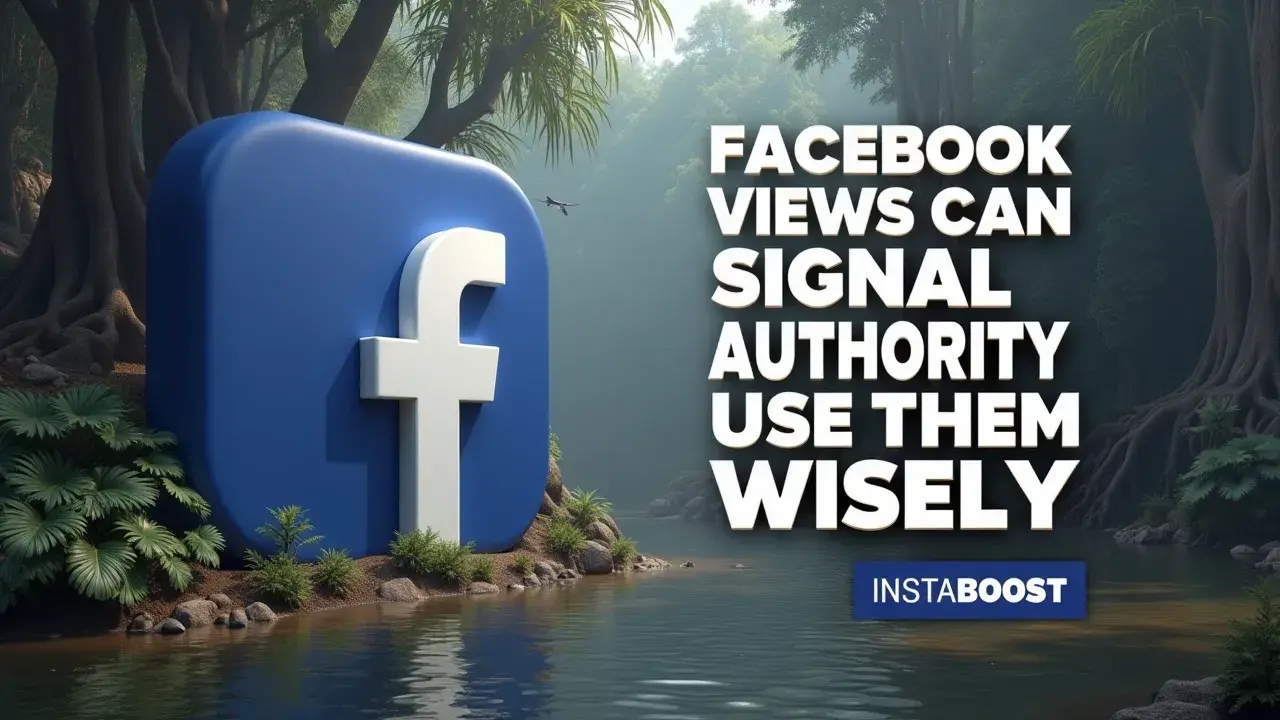Do Facebook Views Signal Authority When Used Wisely?
Facebook views can indicate emerging authority by reflecting trust and reach. Their value depends on context, such as who is watching, how long they engage, and whether attention converts into meaningful actions. Views can mislead when inflated by low intent exposure or non-targeted audiences, so interpreting supporting metrics matters. Focusing on relevant reach, engaged viewing, and follow-on outcomes turns attention into durable authority and a clearer growth path.
Views Are Signals, Not Crowns
A Facebook view can feel like a verdict – proof that a post landed, a brand matters, a creator has pull. But a view isn’t authority. It’s closer to a nod from across the room. Useful, but limited.
If you treat views as signals, not trophies, they get practical: they point to perceived relevance, distribution patterns, and whether people stuck around for a second look. Authority shows up when attention turns into action – comments that add something, shares into new circles, follows that stick, link clicks that leave Facebook and lead somewhere you can measure. The goal is to turn reach into trust without chasing empty spikes. That means pairing views with intent markers like watch time, completion rate, and saves, and with context like traffic source, who amplified it, and which surfaces pushed it, the same way you’d note how small tweaks can quietly increase reach on Facebook without changing what you stand for.
It also means timing and format should follow how your audience behaves. Look at weekday cadence, video length, hooks that fit your niche – the same level of care you’d use when figuring out when to post on TikTok. When a spike comes from a short burst of distribution or a borderline clickbait hook, treat it like sand, not bedrock.
When steady, qualified views line up with downstream actions – email signups, DMs, return viewers – that’s authority building. This piece maps when a view signals trust, when it’s only reach, and how to tune your approach so you stop chasing algorithm applause and start compounding reliable attention. We’ll also touch on testing rhythms – slots, formats, and angles – so you can read the feed the way it reads you.

Credibility Is Borrowed Before It’s Earned
I didn’t get smarter. I started listening better. On Facebook, “authority” often looks like borrowed credibility: distribution vouches for you before people do.
A view isn’t proof you’re right; it’s proof the system let you into a conversation. Treat that like an audition. Ask what the view actually signals. Did it come from friends sharing it (social proof), a Page recommendation (algorithmic lift), or a niche Group (contextual trust)? Each path gives you a different kind of credibility, and each one sets the bar for what you need to do on the next post. If the comments mirror your framing and people save or follow, you’re turning reach into authority.
If reactions are high but shares are thin, you’re entertaining, not persuading. That’s a practical way to read views as signals. Adjust your inputs accordingly: cite a source once per carousel, ground a claim with a single visual stat, and put the “so what” in the first line. The platform rewards clarity that travels. Cross-check with an outside metric – newsletter signups, a waitlist, a booking link – so you don’t get tricked by impressions that look good but don’t do anything.
You can also time tests against known engagement windows (like your Wednesday mid-day spikes) to separate message strength from posting-hour luck; the goal isn’t to chase “best time to post on TikTok” hacks, it’s to normalize for timing so the signal is clean. Over a month, watch which formats earn saves and follows from cold audiences. Those are your authority builders; everything else is reach that doesn’t carry weight yet and even the temptation to buy likes and followers for Facebook is just noise against the harder work of earning trust.
Design a View-to-Authority Loop
Every piece of content should have a job, not fill a slot. Treat Facebook views like signals you can steer: each post tests a small idea about how authority grows. Start by logging where views come from in a notes doc – friend shares, Page recommendations, or a specific Group.
Then assign each asset a role: primer, proof, or payoff. Primers are short, plain takes that get you into the conversation. Proofs carry the receipts – screenshots, data, citations – so curiosity turns into trust. Payoffs connect the dots and move the topic one step forward so people leave feeling a bit sharper. Rotate those roles each week and track three things: qualified retention (did people stay past the hook), second‑touch interactions (saves, shares, Group reposts), and context lift (did Groups or sharp commenters pick it up). If views spike but retention sags, you got reach, not authority – follow with a proof post that tightens the claim and shows your work.
If Groups drive steady, modest views with lots of saves, lean into context: publish follow‑ups that address the most cited counterpoint, and tag your sources. Treat headlines and the first three seconds like an A/B lab – swap verbs, reorder facts, keep the core idea. The point isn’t to chase empty virality; it’s to build a repeatable view‑to‑authority loop where relevance earns distribution, distribution invites scrutiny, and scrutiny strengthens credibility.
Over time, that stacks up – your Facebook views stop being vanity and start signaling real authority. For search spillover, mirror the same roles in a short blog post or YouTube description so people searching “Facebook views authority” or “best posting windows” can trace the path back to you and buy likes for Facebook stories without breaking the flow of how you present your evidence and outcomes.
Authority Isn’t a Volume Knob
I know what burnout smells like. It smells like effort. Here’s the pushback: if you treat Facebook views like fuel, you’ll stomp the gas and stay in place. A view can hint at authority, but it’s weak without context.
Treat it like a lead you need to investigate. Did the spike come from the recommendation feed, a niche Group vouching for you, or a friend-of-friend share pulling you into a new circle? Those are different paths to perceived authority, and they suggest different next steps. Algorithmic lift means the system matched you to a distribution pattern; social proof means people will put their name next to yours; a Group share means you earned trust inside a context that matters.
Don’t blend them. The mistake is thinking “more views” equals “more trust” – it doesn’t. Authority builds when you feed the right loop with small, specific tests: tighten one claim, attach one clear proof (a screenshot, a client note, a result you can show), and ask one focused follow-up that invites expertise rather than applause. You’ll see plenty of advice about timing hacks or even how some people get more views by buying, but those shortcuts only muddy the signal you actually need to read.
If you optimize, do it after you understand your own signals, not before. You’re building a reputation graph that holds up over time, not chasing a traffic blip. So log where views came from, give each post a single authority job, and avoid tactics that inflate impressions without deepening recognition. That restraint is how views turn into credibility – and how you keep effort from burning into smoke.
Close the Loop, Then Raise the Bar
Closure is the start of clarity. You’ve shown that Facebook views can signal authority; now make the loop explicit so it can compound. Pick a cadence – weekly works – where you review what each spike actually meant: not just how many watched, but who came back, who clicked, who left a thoughtful comment, and who invited you into a Group or sent a DM for more.
Create a simple rubric: a view that leads to a save, share, or follow is “authority-adjacent”; a view that prompts off-platform behavior (newsletter signup, purchase, invite) is “authority-confirmed.” Use that grading to cut formats that inflate reach without trust, and double down on threads where your point of view changed someone’s workflow. Add one outside benchmark to avoid getting stuck inside the platform – search behavior is a good start. If your post about timing posts leads to queries like “best times to post on TikTok on Wednesdays,” that’s a cross-signal: your work is creating demand beyond the feed, much like the subtle cues you see when people get more shares on Facebook without any prompting.
Then upgrade the asset behind your most authoritative paths: turn a high‑retention Reel into a pinned guide, a carousel into a short explainer series, a lively comment debate into an FAQ landing page. After that, rerun the test: new hook, same thesis, tighter proof. The aim isn’t endless growth; it’s tighter inference. When views rise, you should be able to say why, which audience, and what kind of authority it conferred. If you can’t, pause. Authority isn’t a volume knob – it’s a pattern you can reproduce on purpose. Use the signal, retire the noise, and let the work make its own case.
Start With Signals, Not Status
If you treat a Facebook view like a merit badge, you’ll chase applause and miss authority. Treat it like a clue. A view means someone paused long enough to catch a glimpse of your point; that’s not credibility yet, but it’s a starting point.
Authority shows up when those views turn into behavior that costs the viewer something – time, thought, money, or social capital. So read views as signals, not trophies: who watched to the end, who saved it, who shared it into a Group, who left a counterpoint you had to answer, who clicked through to your site or newsletter. That’s where the gap between reach and trust gets obvious. Same across platforms – the “best times to post on TikTok on Wednesdays” might bump impressions, but impressions aren’t influence unless they lead someone to return or recommend, and it’s worth remembering that cheap vanity hacks like buy real-looking Facebook reactions confuse the picture more than they clarify it.
Start simple: write your thesis, post consistently, and tag each piece with a hypothesis about who it’s for and what action it should prompt. Then check whether the right people did the right things. If a video on pricing frameworks brings DMs from operators and unsubscribes from dabblers, that’s a fair trade. If a meme racks up views but sparks no next step, call it entertainment, not evidence. After a few cycles, you’ll see patterns: formats that open doors, formats that pull in the wrong crowd, topics that drive off‑platform behavior. Use that map to place fewer, sharper bets. Views can hint at authority – use them to ask better questions, not to declare victory and buy real-looking Facebook reactions.















